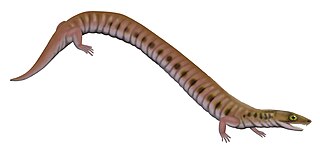Faramea exemplaris is a species of plant in the family Rubiaceae. It is endemic to Peru.

Rhynchonkos is an extinct genus of rhynchonkid microsaur. Originally known as Goniorhynchus, it was renamed in 1981 because the name had already been given to another genus; the family, likewise, was originally named Goniorhynchidae but renamed in 1988. The type and only known species is R. stovalli, found from the Early Permian Fairmont Shale in Cleveland County, Oklahoma. Rhynchonkos shares many similarities with Eocaecilia, an early caecilian from the Early Jurassic of Arizona. Similarities between Rhynchonkos and Eocaecilia have been taken as evidence that caecilians are descendants of microsaurs. However, such a relationship is no longer widely accepted.

Goniorhynchus is a genus of moths of the family Crambidae.

Hypsibius dujardini sensu lato is a species complex of tardigrade in the class Eutardigrada. A member of this complex, Hypsibius exemplaris, is widely used for various research projects pertaining to evolutionary biology and astrobiology. The species was described by Louis Michel François Doyère in 1840.

Goniorhynchus butyrosa is a moth in the family Crambidae. It was described by Arthur Gardiner Butler in 1879. It is found in China, Thailand and Japan.
Goniorhynchus calamitalis is a moth in the family Crambidae. It was described by Snellen in 1898. It is found in Indonesia.
Goniorhynchus chalybaealis is a moth in the family Crambidae. It was described by Snellen in 1892. It is found on Java.
Goniorhynchus clausalis is a moth in the family Crambidae. It was described by Hugo Theodor Christoph in 1881. It is found in Japan and China.
Goniorhynchus flaviguttalis is a moth in the family Crambidae. It was described by Warren in 1896. It is found in India.
Goniorhynchus gulielmalis is a moth in the family Crambidae. It was described by William Jacob Holland in 1900. It is found on Buru in Indonesia.
Goniorhynchus hampsoni is a moth in the family Crambidae. It is found in Peru and Costa Rica.
Goniorhynchus marasmialis is a moth in the family Crambidae. It was described by George Hampson in 1898. It is found on the islands of Bali and Timor in Maritime Southeast Asia.
Goniorhynchus marginalis is a moth in the family Crambidae. It was described by Warren in 1896. It is found in India.
Goniorhynchus obscurus is a moth in the family Crambidae. It was described by George Hampson in 1898. It is found on Ambon Island in Indonesia.
Goniorhynchus octosema is a moth in the family Crambidae. It was described by George Hampson in 1912. It is found in Singapore.

Goniorhynchus pasithea is a moth in the family Crambidae. It was described by James Farish Malcolm Fawcett in 1916. It is found in eastern Africa.
Goniorhynchus pectinalis is a moth in the family Crambidae. It was described by George Hampson in 1898. It is found in Malaysia.
Goniorhynchus plumbeizonalis is a moth in the family Crambidae. It was described by George Hampson in 1896. It is found in the Indian state of Meghalaya, Myanmar and Thailand.
Goniorhynchus salaconalis is a moth in the family Crambidae. It was described by Herbert Druce in 1895. It is found in Panama and Costa Rica.

Sphaerodactylus goniorhynchus, also known as the Jamaican forest sphaero or Cakoarita least gecko, is a species of lizard in the family Sphaerodactylidae. It is endemic to Jamaica.




